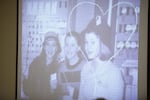It was the year 2000 in the Oregon coast town of Coquille when 15-year-old Leah Freeman went missing and was soon after found dead.
The case went cold for almost a decade before Nicholas McGuffin, Freeman’s boyfriend at the time of her death, was indicted for her murder, without any evidence connecting him to the crime.
The jury was unable to come to a unanimous decision to convict McGuffin of murder — Oregon is the only state in the nation that allows for non-unanimous jury convictions for all felonies except murder — so, he was acquitted of the murder charge and was eventually convicted of manslaughter in 2011, with a non-unanimous 10-2 verdict.
He has been in prison for about nine years of his 10-year sentence.
Now, McGuffin has a chance at getting his charges cleared, after a judge overturned his conviction due to proof of formerly undisclosed evidence revealing another man’s DNA was at the crime scene.
McGuffin advocated for his innocence this past August at a post-conviction trial.
Janis Puracal is an attorney with the Forensic Justice Project, a Portland nonprofit focused on preventing and correcting wrongful convictions based on forensic evidence. She represented McGuffin at that trial.
“There was no evidence against him. He just happened to be her boyfriend at the time,” Puracal said. “There were no eyewitnesses, there was no DNA connecting him to the crime, and there was no other evidence that tied him to anything that happened to her.”

Nicholas McGuffin sheds tears at his trial in 2011.
The World Newspaper
Around the time Freeman’s body was discovered, the Oregon State Police Crime Lab found DNA on her shoes that wasn’t connected to McGuffin, but to another unknown man.
Puracal says she found out about the evidence through DNA tests that were in the nearly decade-old technical documents in the initial trial.
“We consulted with a DNA expert,” Puracal said. “She reviewed the charts, graphs, and raw data from the DNA testing in 2000. She was the one who saw that there was unidentified male DNA on both of the victim’s shoes that had not been reported by the state lab. There was unidentified male DNA in the victim’s [spilled] blood and it was never reported.”
The DNA didn’t match McGuffin, any of the male police officers on the case or others close to Freeman.
Analysts chose not to disclose that information due to an internal policy at the time. The amount of DNA was small enough that it didn’t meet a specific threshold, which gave the analysts discretion on whether to report it.
Therefore, the jury did not have that information when it made its decision.
“It never should’ve happened this way,” Puracal said. “We would expect our state crime lab to be fair and transparent and be open about exculpatory DNA.”
McGuffin’s legal counsel petitioned for him to get a post-conviction trial by arguing he had ineffective counsel in his original trial, as well as other issues, including the big DNA revelation.
Puracal argued that the non-disclosure of the DNA evidence is a “Brady violation.”
“That’s information that should have been disclosed before the original trial and wasn’t disclosed,” she said. “So we brought a Brady claim that says, ‘The state should have disclosed this evidence and had they disclosed it to the jury, the jury would have seen that it would’ve made a difference.’”
Paul Reim, an attorney with the Oregon Department of Justice, defended the crime lab’s decision during McGuffin’s post-conviction trial.
“This was a different world back then, 2000; it’s very different than it is now,” Reim said. “There were some protocols in place that allowed the DNA analyst to either report the unknown minor male profile or not. They were very cautious back then because they didn’t know about all the DNA stuff that was out there, so they were cautious and conservative in their report writing.”

A photo of Leah Freeman from Nicholas McGuffin's 2011 trial.
The World Newspaper
He also argued that it wasn’t technically a Brady violation.
“There wasn’t a violation here at all. Trial counsel had the bench notes,” Reim said. “The state wasn’t remiss. They provided the information.”
Malheur County Circuit Court Judge Patricia Sullivan ultimately agreed with Puracal, that the fact the DNA evidence wasn’t explicitly disclosed could have changed the entire outcome of the original trial. Sullivan also agreed that McGuffin’s original attorneys’ not looking into that evidence counts as ineffective assistance of counsel.
“Review of the results show that unknown male DNA was found on both shoes, not belonging to Petitioner [McGuffin], and those results were known in 2001 and 2002 when the reports were generated,” Judge Sullivan said in her Nov. 29 ruling.
“There is a factual dispute as to whether the OSP lab protocols in 2001 and 2002 required the trace DNA amounts found be reported,” she continued. “The case went to trial in 2011. Significant advances in the detection of trace amounts of DNA occurred in that 10-year period, and by 2011, there is no dispute the results would have been reported at that time, or, that had a defense expert asked, the results would have been disclosed.”
The lab violated McGuffin's constitutional rights by not disclosing the evidence at his trial, Puracal said.
"Every defendant in a criminal case has a constitutional right to know if there is evidence that proves that person is innocent," she said. "And what the court found here is that the lab knew about such evidence, DNA evidence, but didn't disclose it, and that's a constitutional violation."
Puracal is happy that McGuffin’s conviction was overturned, but she still has worries.
“We have no idea how many other cases exist in Oregon where there’s exculpatory DNA that the crime lab didn’t disclose,” Puracal said. “We have no idea how many other cases there might be with DNA evidence that might prove that we’ve got innocent people in Oregon prisons.”
She said she hopes the ruling from the court prompts the lab to make an inquiry into what other cases may have been affected similarly.
As for McGuffin, a few things could happen next.
The Oregon Department of Justice could appeal the post-conviction ruling — it has until Dec. 30 to decide that.
If the state doesn’t appeal, the case would go back to the Coos County District Attorney, who could either decide to retry the whole case or dismiss McGuffin’s charges.
“Mr. McGuffin is definitely ready to go home. He’s been incarcerated now for over nine years for a crime he didn’t commit,” Puracal said. “This ruling is a big deal for him and it’s an exciting ruling for him to get to after serving all this time. I think part of him, though, really just wants to know what happened back in 2000.
“I think we all want to know really what happened to Ms. Freeman and we may never know the answer to that.”
